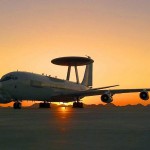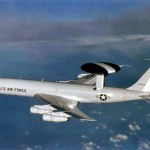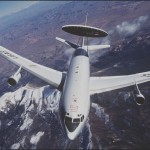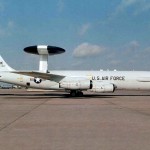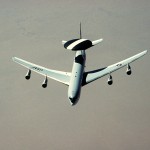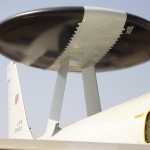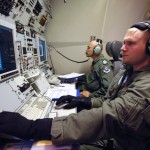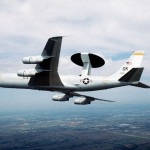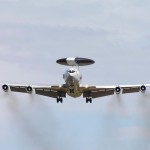
An underrated workhorse, the E-3 Airborne Warning and Control System (AWACS) jet lives up to its moniker, “Sentry.” Derived from Boeing’s 707, the E-3 began its service when the first unit was delivered to Tinker AFB, Oklahoma in 1977. Since then, the USAF has procured a total of 34 “Sentries.” Currently, 31 are in active service with 27 stationed at Tinker.
The E-3 has a max speed of 530 mph with four Pratt & Whitney TF33-P100A turbofan engines. Its ceiling is 41,000 feet. With a full fuel load, the aircraft has an operational range of 4,000 nautical miles, which gives it about eight hours before requiring refueling. The E-3 is capable of aerial refueling. The length of the aircraft is 152 feet, 11 inches with a wingspan of 145 feet, nine inches.
The most important part of the E-3, however, is its rotating, domed radar. The radar is held 11 feet above the fuselage. The radar system itself is Westinghouse Corporation’s AN/APY-1 or AN/APY-2 passive electronically scanned array radar system. This system uses pulse-Doppler technology.
Pulse-Doppler is a 4D radar technology, meaning it can not only detect a target’s three-dimensional location but also calculate its radial velocity (also called range-rate). The pulse technology is also excellent at avoiding clutter. This helps crews in tracking and focusing on “targets of interest.”

The role of the E-3 “Sentry” is to be the eyes of the combat zone. It flies high and obscurely, evading the detection of opposing forces. From its vantage point, it can highlight everything around it. The amount of incoming information is worthy of the large mission crew. Ground targets, aerial targets, friend/foe; their velocities and locations are all intercepted by the radar. The information is disseminated to all friendly assets. From a single E-3 an entire battlefield can be managed.
Thanks to innovation and technology, command of the air has never been so complete. Early imaginings and theories focused on daring reconnaissance missions. Now, there is no need to cross enemy lines or risk exposure. The E-3 “Sentry” and its radar can completely map a combat zone and give commanders the freedom and flexibility of knowing what’s on the other side. In an ever-evolving battlefield, information is key and the E-3 provides all important information in real-time.
As the old 707 airframe is outdated and no longer in production, future AWACS jets will use the newer 767 airframe. The Japan Air Self Defense Force has already fitted the E-3 “mission package” into a Boeing 767. Other future improvements include a new “air battle management” section under the USAF’s Block 40/45 upgrades as well as utilizing more efficient P&W JT8D-219 turbofan engines.
The “Sentry” is an incredibly important asset to allied Air Forces. It is underrated and often overlooked. Perhaps because it lacks the flash of fighters, bombers and recon planes? It may also be due to its few numbers, which should highlight how impressive the aircraft is. For all it does, it doesn’t take many. Many recent American undertakings owe their successes to the E-3.
Specifications
General
Crew: Four flight crew and 13-19 mission crew
Length: 152 ft 11 in
Wingspan: 145 ft 9 in
Height: 41 ft 4 in
Empty weight: 185,000 lb
Max. takeoff weight: 347,000 lb
Engines: Four Pratt and Whitney TF33-PW-100A turbofan, 21,500 lbf each
Performance
Maximum speed: 530 mph
Range: 4,000 nmi (8 hrs)
Service ceiling: 41,000 ft
Essential Reading and More
Online Resources:
- Wikipedia
- Global Security
- Military Today
- Raytheon APQ174 Official site
- U.S. Air Force Official Fact Sheet
